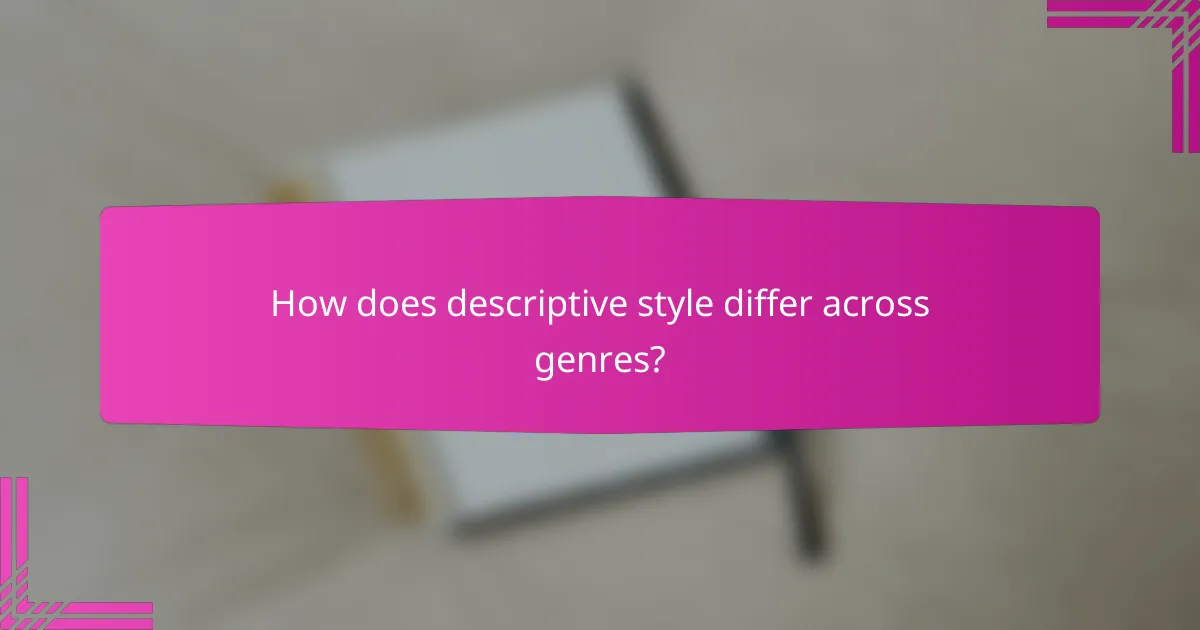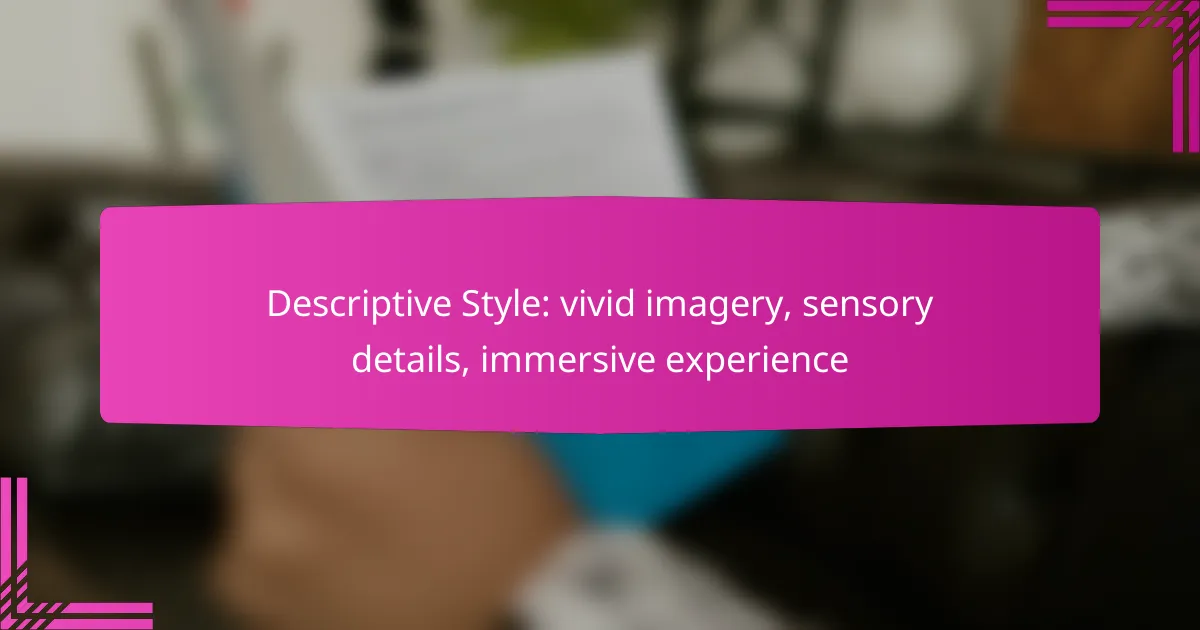Descriptive writing breathes life into storytelling, inviting readers to immerse themselves in the rich tapestry of Australia’s landscapes and cultures. By weaving together vivid imagery and sensory details, authors can evoke emotions and create a lasting connection with their audience. Techniques such as metaphors and similes enhance this experience, transforming simple narratives into vibrant journeys that resonate deeply with the imagination.

How can descriptive style enhance storytelling in Australia?
Descriptive style significantly enhances storytelling in Australia by creating a vivid connection between the narrative and the reader’s imagination. It allows authors to paint detailed pictures of landscapes, cultures, and experiences, making the story more engaging and relatable.
Creates vivid imagery
Vivid imagery brings scenes to life, allowing readers to visualize the Australian outback, with its sprawling red deserts and vibrant sunsets. By using descriptive language, writers can evoke powerful images that transport the reader to iconic locations like the Great Barrier Reef or the lush rainforests of Queensland.
For instance, describing the sound of waves crashing against the Sydney Harbour can create a mental picture that enhances the emotional impact of a scene. Writers should focus on specific details, such as colors, shapes, and movements, to craft compelling imagery.
Engages sensory details
Engaging sensory details immerses readers in the story by appealing to their senses. Descriptions of the salty sea breeze, the warmth of the sun on the skin, or the aroma of eucalyptus trees can evoke strong feelings and memories, making the narrative more relatable.
Incorporating sensory details helps readers experience the story on a deeper level. For example, describing the taste of fresh seafood at a coastal market can transport readers to a bustling Australian seaside town, enhancing their connection to the narrative.
Immerses the reader
Immersive storytelling draws readers into the world of the narrative, making them feel like active participants. By using descriptive style effectively, authors can create a sense of place that resonates with the Australian landscape and culture, from the bustling streets of Melbourne to the serene beaches of Byron Bay.
To achieve immersion, writers should balance detailed descriptions with the pacing of the story. Avoid overwhelming readers with excessive detail; instead, sprinkle sensory elements throughout the narrative to maintain engagement and enhance the overall experience.

What techniques improve descriptive writing?
Improving descriptive writing involves using techniques that create vivid imagery and engage the reader’s senses. Key methods include employing metaphors, incorporating similes, and utilizing sensory language to paint a more immersive picture.
Use of metaphors
Metaphors enhance descriptive writing by making comparisons that evoke strong imagery. Instead of saying “the night was dark,” you might say “the night was a black velvet curtain,” which conjures a more vivid image in the reader’s mind.
When using metaphors, consider the emotions you want to evoke. A well-chosen metaphor can transform a simple description into a powerful image. For example, describing a stormy sea as “a wild beast thrashing against the shore” adds intensity and drama.
Incorporating similes
Similes, which compare two different things using “like” or “as,” can make descriptions relatable and clear. For instance, saying “her smile was like sunshine breaking through clouds” creates a warm, inviting image that readers can easily visualize.
To effectively use similes, ensure they are relevant and enhance the description. Avoid clichés, as they can dilute the impact. Instead, strive for fresh comparisons that resonate with the reader’s experiences.
Utilizing sensory language
Sensory language engages the reader’s senses—sight, sound, smell, taste, and touch—making descriptions more immersive. For example, instead of saying “the cake was delicious,” describe it as “the cake was a rich chocolate delight, melting in your mouth with a hint of vanilla.” This invites the reader to experience the flavor.
When incorporating sensory details, aim for specificity. Instead of vague terms, use precise descriptors that evoke strong images. For instance, “the crisp autumn leaves crunched underfoot” provides a clear auditory and tactile experience that draws the reader in.

Which tools assist in developing descriptive style?
Several tools can enhance your descriptive writing style by providing suggestions for clarity, organization, and overall effectiveness. Utilizing these tools can help you create vivid imagery and sensory details that engage your readers more deeply.
Grammarly for style suggestions
Grammarly offers real-time writing assistance that focuses on style, tone, and clarity. By analyzing your text, it provides suggestions to improve word choice and sentence structure, helping you create more evocative descriptions.
For instance, if you describe a sunset, Grammarly might suggest replacing “the sun went down” with “the sun dipped below the horizon,” enhancing the imagery. Regularly using Grammarly can refine your descriptive style over time.
Hemingway Editor for clarity
The Hemingway Editor is designed to improve the readability of your writing. It highlights complex sentences and passive voice, encouraging you to simplify your language, which is crucial for effective descriptive writing.
For example, a sentence like “The aroma of freshly baked bread filled the air” could be simplified to “Freshly baked bread filled the air with its aroma,” making it more direct and impactful. This tool helps ensure your descriptions are clear and engaging.
Scrivener for organization
Scrivener is a powerful writing software that aids in organizing your projects. It allows you to break your work into manageable sections, making it easier to focus on developing specific descriptive elements without losing sight of the overall narrative.
Using Scrivener, you can create folders for different scenes or characters, keeping your descriptive notes and drafts in one place. This organization helps maintain consistency in your imagery and sensory details throughout your writing.

What are the common pitfalls in descriptive writing?
Common pitfalls in descriptive writing include overusing adjectives, lacking focus on the main idea, and neglecting the audience’s perspective. These mistakes can dilute the impact of your writing and confuse readers, making it essential to recognize and avoid them.
Overusing adjectives
While adjectives can enhance descriptions, overusing them can lead to cluttered and confusing prose. Instead of relying on numerous adjectives, focus on strong nouns and verbs that convey meaning more powerfully. For instance, instead of saying “the very tall, dark tree,” simply refer to “the towering oak.”
To maintain clarity, limit yourself to one or two well-chosen adjectives per noun. This approach helps create vivid imagery without overwhelming the reader. A good rule of thumb is to ask whether each adjective adds significant value to the description.
Lack of focus on the main idea
Descriptive writing should revolve around a central theme or idea. When writers stray from this focus, descriptions can become disjointed and ineffective. To avoid this, outline your main idea before writing and ensure every detail supports it.
Consider using a checklist to evaluate your descriptions. Ask yourself if each detail relates to the main idea and contributes to the overall image you want to create. If a detail feels extraneous, consider removing it to maintain clarity and coherence.
Neglecting the audience’s perspective
Understanding your audience is crucial in descriptive writing. Failing to consider their perspective can result in descriptions that resonate poorly or miss the mark entirely. Tailor your language and imagery to match the experiences and expectations of your readers.
Engage your audience by using relatable references and sensory details that evoke shared experiences. For example, instead of describing a sunset in abstract terms, paint a picture that evokes emotions, such as “the sky blazed with fiery oranges and pinks, reminiscent of a childhood summer evening.” This approach fosters a connection and enhances the immersive quality of your writing.

How does descriptive style differ across genres?
Descriptive style varies significantly between genres, influencing how readers engage with the text. In fiction, vivid imagery often drives emotional connection, while non-fiction typically prioritizes clarity and factual accuracy.
Fiction vs. non-fiction
In fiction, descriptive style is essential for creating immersive worlds and relatable characters. Authors use sensory details to evoke emotions, painting scenes that transport readers into the narrative. For example, a description of a bustling market might include the vibrant colors of fresh produce, the sounds of vendors calling out, and the aroma of spices wafting through the air.
Conversely, non-fiction relies on a more straightforward descriptive style aimed at informing rather than entertaining. While it can include vivid imagery, the focus is on clarity and precision. A travel article, for instance, may describe a destination’s landscape but will emphasize factual information, such as historical significance or cultural practices, to enhance understanding.
Poetry vs. prose
Poetry often employs a highly condensed and evocative descriptive style, using metaphor and rhythm to create powerful imagery. Each word is chosen for its emotional weight, allowing poets to convey complex feelings and ideas in a few lines. For example, a poet might describe a sunset not just as beautiful but as a “fiery farewell to the day,” invoking deeper reflections on time and change.
In contrast, prose allows for more expansive descriptions, providing context and detail that can develop characters and settings over longer passages. While prose can be lyrical, it typically balances imagery with narrative flow. A novelist might spend several paragraphs detailing a character’s surroundings, blending sensory details with the story’s progression to maintain reader engagement.



